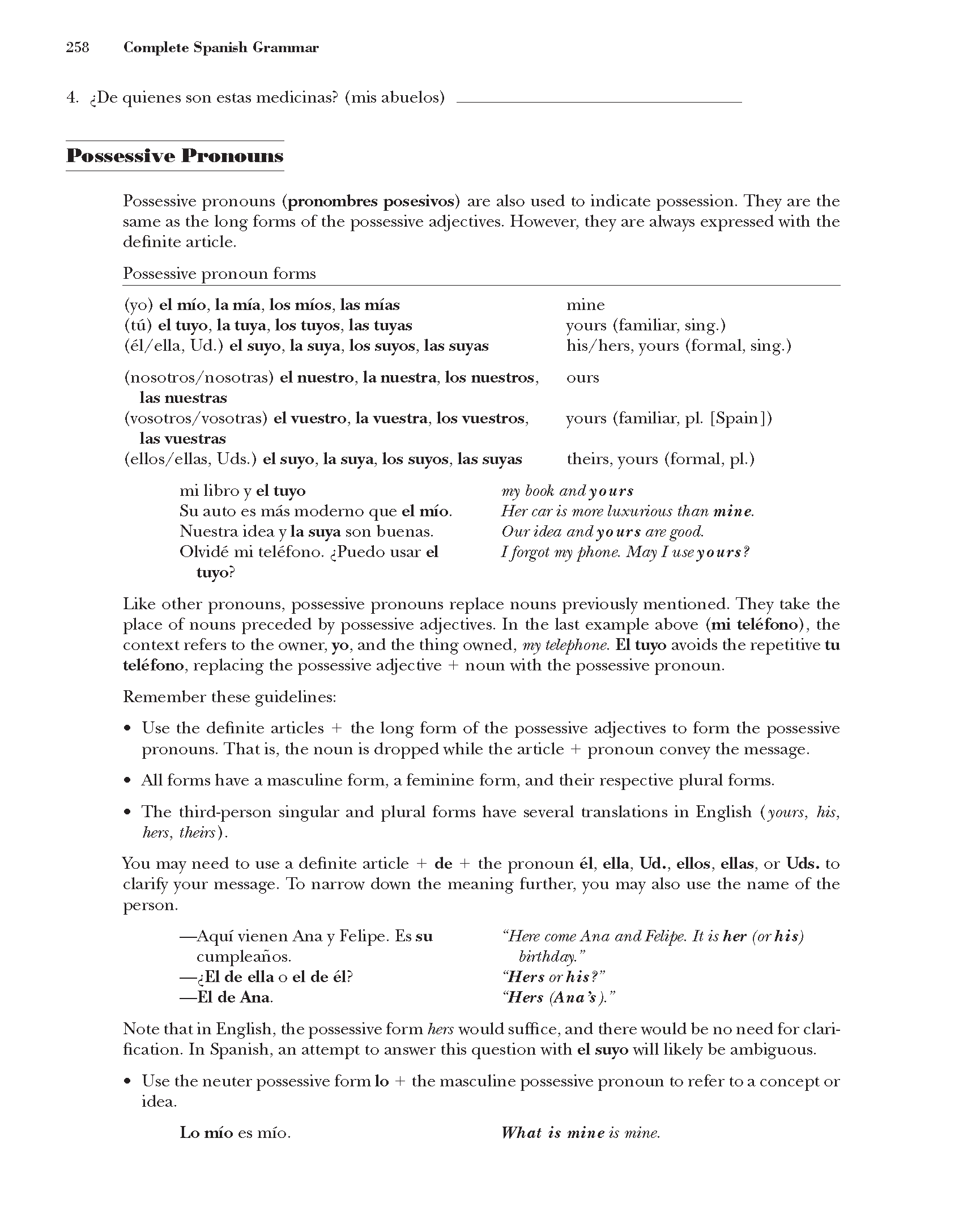CSG269

258 Complete Spanish Grammar 4. ^De quienes son estas medicinas? (mis abuelos)
Possessive Pronouns
Possessive pronouns (pronombres posesivos) are also used to indicate possession. They are the same as the long forms of the possessive adjectives. However, they are always expressed with the definite article.
Possessive pronoun forms
minę
yours (familiar, sing.) his/hers, yours (formal, sing.)
(yo) el nho, la nha, los nhos, las mias
(tu) el tuyo, la tuya, los tuyos, las tuyas
(el/ella, Ud.) el suyo, la suya, los suyos, las suyas
(nosotros/nosotras) el nuestro, la nuestra, los nuestros, ours las nuestras
(vosotros/vosotras) elvuestro, lavuestra, los yuestros, yours (familiar, pl. [Spain]) las yuestras
(ellos/ellas, Uds.) el suyo, la suya, los suyos, las suyas theirs, yours (formal, pl.)
mi libro y el tuyo
Su auto es mas moderno que el nho. Nuestra idea y la suya son buenas. 01vide mi telefono. ^Puedo usar el tuyo?
my book and yours
Her caris morę luxurious than minę.
Our idea and yours are good.
I forgot my phone. May I use yours?
Like other pronouns, possessive pronouns replace nouns previously mentioned. They take the place of nouns preceded by possessive adjectives. In the last example above (mi telefono), the context refers to the owner, yo, and the thing owned, my telephone. El tuyo avoids the repetitive tu telefono, replacing the possessive adjective + noun with the possessive pronoun.
Remember these guidelines:
• Use the definite articles + the long form of the possessive adjectives to form the possessive pronouns. Thatis, the noun is dropped while the article + pronoun convey the message.
• Ali forms have a masculine form, a feminine form, and their respective plural forms.
• The third-person singular and plural forms have several translations in English (yours, his, hers, theirs).
You may need to use a definite article + de + the pronoun el, ella, Ud., ellos, ellas, or Uds. to clarify your message. To narrow down the meaning further, you may also use the name of the person.
—Aqui vienen Ana y Felipe. Es su “Here come Ana andFelipe. It is her (orhis)
cumpleanos. birthday. ”
—^E1 de ella o el de el? “Hers orhis?”
—El de Ana. “Hers (Ana ’s). ”
Notę that in English, the possessive form hers would suffice, and there would be no need for clari-fication. In Spanish, an attempt to answer this question with el suyo will likely be ambiguous.
• Use the neuter possessive form lo + the masculine possessive pronoun to refer to a concept or idea.
Lo mio es nho.
What is minę is minę.
Wyszukiwarka
Podobne podstrony:
CSG313 302 Complete Spanish Grammar <:Quien?, <:Quienes? Who? <:Quien?, &
CSG031 20 Complete Spanish Grammar 2-2ejercicio lQue hacen estas personas? Choose the infinitive tha
CSG245 234 Complete Spanish Grammar • With infinitives and the gerundio (-ando, -iendo) forms, prono
CSG293 282 Complete Spanish Grammarejercicio l Que clase de relación existe entre los elementos de l
CSG185 174 Complete Spanish Grammar 3. Yo comprarfa un equipo de sonido nuevo si (
więcej podobnych podstron